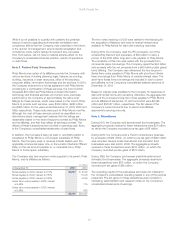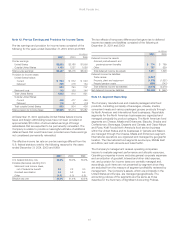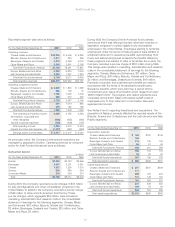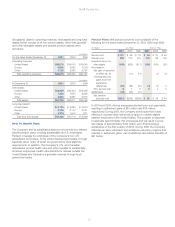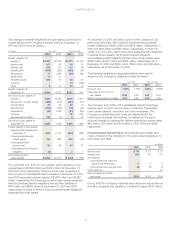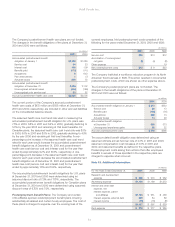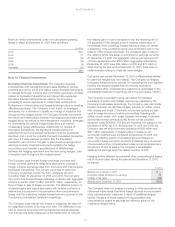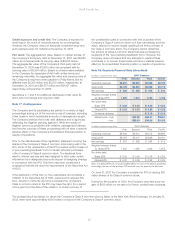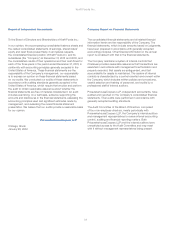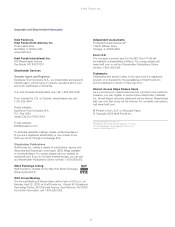Kraft 2001 Annual Report Download - page 61
Download and view the complete annual report
Please find page 61 of the 2001 Kraft annual report below. You can navigate through the pages in the report by either clicking on the pages listed below, or by using the keyword search tool below to find specific information within the annual report.
Kraft Foods Inc.
55
Credit exposure and credit risk: The Company is exposed to
credit loss in the event of nonperformance by counterparties.
However, the Company does not anticipate nonperformance and
such exposure was not material at December 31, 2001.
Fair value: The aggregate fair value, based on market quotes, of
the Company’s third-party debt at December 31, 2001 was $9,360
million as compared with its carrying value of $9,355 million.
The aggregate fair value of the Company’s third-party debt at
December 31, 2000 was $3,605 million as compared with its
carrying value of $3,554 million. Based on interest rates available
to the Company for issuances of debt with similar terms and
remaining maturities, the aggregate fair value and carrying value of
the Company’s long-term notes payable to Philip Morris and its
affiliates were $5,325 million and $5,000 million, respectively, at
December 31, 2001 and $21,357 million and $21,407 million,
respectively, at December 31, 2000.
See Notes 3, 7 and 8 for additional disclosures of fair value for
short-term borrowings and long-term debt.
Note 17. Contingencies:
The Company and its subsidiaries are parties to a variety of legal
proceedings arising out of the normal course of business, including
a few cases in which substantial amounts of damages are sought.
The Company believes that it has valid defenses and is vigorously
defending the litigation pending against it. While the results of
litigation cannot be predicted with certainty, management believes
that the final outcome of these proceedings will not have a material
adverse effect on the Company’s consolidated financial position or
results of operations.
Prior to the effectiveness of the registration statement covering the
shares of the Company’s Class A common stock being sold in the
IPO, some of the underwriters of the IPO provided written copies of
a “pre-marketing feedback” form to certain potential purchasers
of the Company’s Class A common stock. The feedback form
was for internal use only and was designed to elicit orally certain
information from designated accounts as part of designing strategy
in connection with the IPO. This form may have constituted a
prospectus that did not meet the requirements of the Securities Act
of 1933.
If the distribution of this form by the underwriters did constitute a
violation of the Securities Act of 1933, persons who received this
form, directly or indirectly, and who purchased the Company’s
Class A common stock in the IPO may have the right, for a period
of one year from the date of the violation, to obtain recovery of
the consideration paid in connection with their purchase of the
Company’s Class A common stock or, if they had already sold the
stock, attempt to recover losses resulting from their purchase of
the Class A common stock. The Company cannot determine
the amount of Class A common stock that was purchased by
recipients of the “pre-marketing feedback” form. However, the
Company does not believe that any attempts to rescind these
purchases or to recover these losses will have a material adverse
effect on its consolidated financial position or results of operations.
Note 18. Quarterly Financial Data (Unaudited):
(in millions, except per share data) 2001 Quarters
First Second Third Fourth
Operating revenues $8,367 $8,692 $8,056 $8,760
Gross profit $4,100 $4,300 $3,832 $4,112
Net earnings $ 326 $ 505 $ 503 $ 548
Weighted average shares
for diluted EPS 1,455 1,510 1,735 1,736
Per share data:
Basic EPS $ 0.22 $ 0.33 $ 0.29 $ 0.32
Diluted EPS $ 0.22 $ 0.33 $ 0.29 $ 0.32
Dividends declared $ 0.13 $ 0.13
Market price—high $32.00 $34.81 $35.57
—low $29.50 $30.00 $31.50
(in millions, except per share data) 2000 Quarters
First Second Third Fourth
Operating revenues $6,460 $6,974 $6,215 $6,883
Gross profit $3,079 $3,417 $2,958 $3,161
Net earnings $ 470 $ 568 $ 548 $ 415
Weighted average shares
for diluted EPS 1,455 1,455 1,455 1,455
Per share data:
Basic EPS $ 0.32 $ 0.39 $ 0.38 $ 0.29
Diluted EPS $ 0.32 $ 0.39 $ 0.38 $ 0.29
Basic and diluted EPS are computed independently for each of the periods presented.
Accordingly, the sum of the quarterly EPS amounts may not agree to the total year.
On June 13, 2001, the Company completed an IPO by issuing 280
million shares of its Class A common stock.
During the third quarter of 2000, the Company recorded a pre-tax
gain of $139 million on the sale of a French confectionery business.
The principal stock exchange, on which the Company’s Class A common stock is listed, is the New York Stock Exchange. At January 31,
2002, there were approximately 1,500 holders of record of the Company’s Class A common stock.


